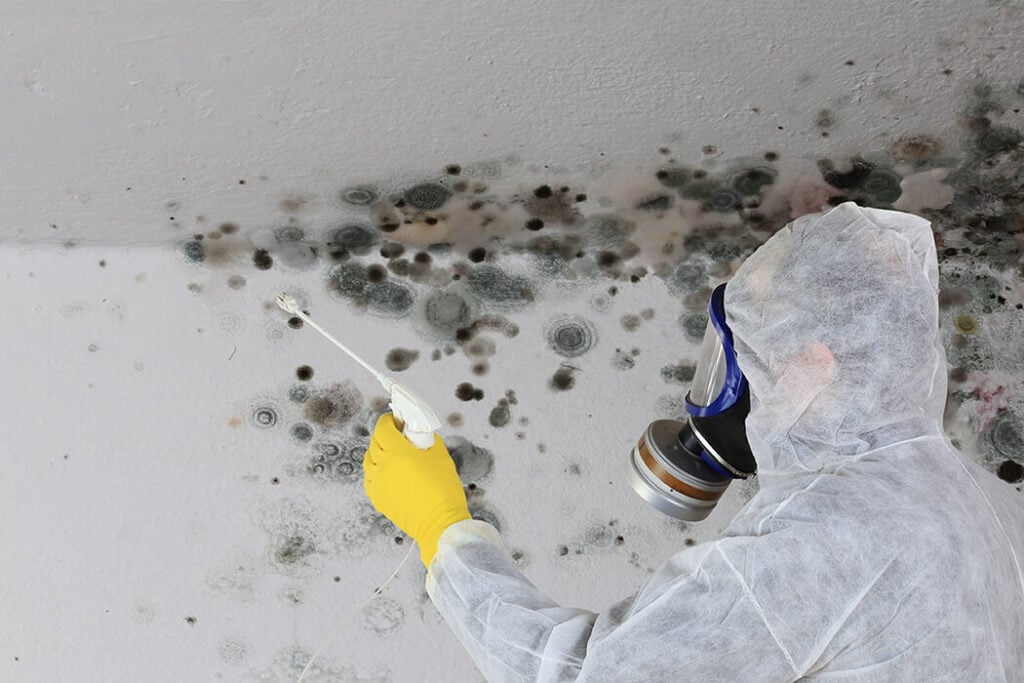
Could mold in your home be causing unexplained health issues for you and your family? It’s possible. When mold grows on a surface, the spores are released into the air where they can be easily inhaled. These spores in small amounts may not be harmful, however as the spores grow, mold can cause significant health problems.
6 Common Household Molds
Here are the 6 most common types of household mold and how each can affect your health.
Cladosporium Mold
This household mold varies in color from blackish brown to gray and olive green, and the clusters of spots spread quickly if not cleaned. Cladosporium grows in organic materials, including dead plants, wood, insulation and food. It usually appears where moisture is present, such as basements, and other dark, damp environments.
Health Effects: Although Cladosporium is not toxic to humans, it can cause allergic reactions in some people, especially those with asthma, allergies and weakened immune systems. Symptoms are similar to those associated with hay fever, and include sinus congestion or runny nose, sneezing, coughing, itchy throat and eyes, watery or red eyes, and hives.
Aspergillus Mold
The most common species of aspergillus found in homes are black on the surface and whitish or yellow underneath, yellowish-green or reddish-brown. This mold grows very quickly and is found on dead leaves and other decaying vegetable matter, as well as household food and ground spices. It can grow in walls, insulation and clothing, and be carried inside on shoes and grow on carpet. It is commonly found in humid, moist areas within a home, such as basements and bathrooms.
Health Effects: Most of us breathe in aspergillus spores every day without getting sick. However, people with lung disease or weakened immune systems can develop an infection known as aspergillosis in the lungs or sinuses, which can spread to the bloodstream and other parts of the body with fatal complications. Symptoms include wheezing, coughing, shortness of breath, chest pain, fever and chills.
Penicillium Mold
This common household mold is fuzzy in appearance, and has a distinct blue-green color, though it can vary from dark green with a bluish tint to bright turquoise. Penicillium is well known for its use in food and drug production, but it can also grow on walls, insulation and moist organic materials, including ceiling tiles and wood. Penicillium prefers cool, damp places, where it can quickly take hold and multiply.
Health Effects: Airborne penicillium spores can cause congestion, coughing and eye irritation, and the spores can irritate the stomach if ingested. For those who are immunocompromised, the risks are higher for serious infections.
Alternaria Mold
The physical characteristics of Alternaria mold include a velvety appearance and a dark green, gray or black color. It doesn’t require as much water to grow as other molds, and is typically an outdoor fungus found in vegetation in dry, warm climates. However, Alternaria also thrives in humid or damp areas inside a home, and is commonly found in bathrooms, around windows, on carpet and clothing.
Health Effects: Alternaria can cause allergic rhinitis, or hay fever, and other respiratory problems. Symptoms are similar to the common cold and include runny nose, congestion, coughing, a sore throat and itchy, irritated eyes. Alternaria has also been associated with severe, in some cases life-threatening, exacerbations of asthma, and poses serious health risks to those with emphysema or COPD.
Stachybotrys Mold
Often referred to as “toxic black mold”, stachybotrys is dark green or black in color with a slimy appearance and a potent smell similar to rotting wood. It requires constant moisture to grow, and is most common when there is flooding, water damage, leaks or condensation in a home. Stachybotrys tends to grow on materials with a high cellulose content, such as drywall, wallpaper, ceilings, floorboards and subfloors.
Health Effects: Stachybotrys can cause respiratory problems, such as congestion, wheezing, coughing and asthma, as well as central nervous system issues, including headaches, dizziness, mental fatigue, difficulty sleeping and joint pain. Some species of Stachybotrys produce mycotoxins which can be harmful when inhaled or ingested.
Memnoniella Mold
Commonly found growing alongside stachybotrys on water damaged construction materials in the home, memnoniella is the other “toxic black mold”. It, too, is black and slimy in appearance, and some species of the mold produce mycotoxins which are poisonous to humans when inhaled and ingested. The major difference between the two is that memnoniella mold spores are smaller than stachybotrys.
Health Effects: Memnoniella mold produces similar allergy symptoms as strachybotrys, but because it is smaller, it is easier to penetrate the lung lining. As a result, it can seriously affect asthma sufferers and those with emphysema, COPD and other lung diseases.
What to Do if You Suspect You Have Mold in Your Home
All molds have the potential to cause health complications. The severity depends on the amount of exposure, and other underlying health issues and sensitivities, more so than it does on the type of mold. Contrary to common belief, it is not necessary to determine the type of mold you have growing in your home. All molds are treated the same with regard to risk and removal.
Because of the potential health risks associated with mold, it’s best to consult a mold remediation specialist for cleanup and removal. MacFawn Fire & Flood Restoration specializes in both residential and commercial mold remediation and removal in Albany NY, Worcester MA, Media PA and the Tampa Bay area.
We follow strict health and safety guidelines, and use a multi-step mold removal process, which includes fixing the conditions that are causing the mold to grow, removing all damaged materials, and treating the affected areas with non-toxic antimicrobials to deter mold from returning.
Contact us online or call (877) MACFAWN. We are available 24 hours a day, 365 days a year

